Polycentric Spatial Structure Evolution and Influencing Factors of the Kunming–Yuxi Urban Agglomeration: Based on Multisource Big Data Fusion
Abstract
1. Introduction
2. Materials and Methods
2.1. Study Area
2.2. Study Data
2.3. Methods
2.3.1. Image Fusion Based on Multiscale Transform
2.3.2. Anselin Local Moran’s I
2.3.3. Geographical Detector
3. Results
3.1. Multisource Big Data Fusion
3.2. The Evolution of the Polycentric Spatial Structure of Urban Agglomeration
3.3. Analysis of Factors Influencing Polycentric Spatial Structure
4. Discussion
5. Conclusions
Author Contributions
Funding
Data Availability Statement
Conflicts of Interest
References
- Howard, E. Garden Cities of Tomorrow; Mit Press: Cambridge, MA, USA, 1965; Volume 23. [Google Scholar]
- Geddes, P. Cities in Evolution: An Introduction to the Town Planning Movement and to the Study of Civics; Williams: London, UK, 1915. [Google Scholar]
- Gottmann, J. Megalopolis or the Urbanization of the Northeastern Seaboard. Econ. Geogr. 1957, 33, 189. [Google Scholar] [CrossRef]
- Gottmann, J. Megalopolitan systems around the world. Ekistics 1976, 41, 109–113. [Google Scholar]
- Lang, R.; Knox, P.K. The New Metropolis: Rethinking Megalopolis. Reg. Stud. 2009, 43, 789–802. [Google Scholar] [CrossRef]
- Fang, C.; Song, J.; Zhang, Q. The formation, development and spatial heterogeneity patterns for the structures system of urban agglomerations in China. Acta Geogr. Sin. Chin. Ed. 2005, 60, 827. [Google Scholar]
- Liu, Y.; Zhang, X.; Pan, X.; Ma, X.; Tang, M. The spatial integration and coordinated industrial development of urban agglomerations in the Yangtze River Economic Belt, China. Cities 2020, 104, 102801. [Google Scholar] [CrossRef]
- Meng, Q.; Wang, C.; Wang, C. Examining the Evolution of China’s Urban Interlocking Networks Based on the Spatial Agglomeration of Producer Services. J. Urban Plan. Dev. 2022, 148, 04021063. [Google Scholar] [CrossRef]
- Liu, G.; Yao, X.; Luo, Z.; Kang, S.; Long, W.; Fan, Q.; Gao, P. Agglomeration centrality to examine spatial scaling law in cities. Comput. Environ. Urban Syst. 2019, 77, 101357. [Google Scholar] [CrossRef]
- Frings, H.; Kamb, R. The relative importance of portable and non-portable agglomeration effects for the urban wage premium. Reg. Sci. Urban Econ. 2022, 95, 103786. [Google Scholar] [CrossRef]
- Ma, D.; Zhu, Q. Innovation in emerging economies: Research on the digital economy driving high-quality green development. J. Bus. Res. 2022, 145, 801–813. [Google Scholar] [CrossRef]
- Chen, Y.; Zhu, M.; Lu, J.; Zhou, Q.; Ma, W. Evaluation of ecological city and analysis of obstacle factors under the background of high-quality development: Taking cities in the Yellow River Basin as examples. Ecol. Indic. 2020, 118, 106771. [Google Scholar] [CrossRef]
- Odell, H.; Navarro-López, E.M.; Pinto, N.; Deas, I. Detecting shifts in metropolitan structure: A spatial network per-spective. Environ. Plan. B Urban Anal. City Sci. 2022, 49, 1912–1928. [Google Scholar] [CrossRef]
- Hillier, B.; Hanson, J. The Social Logic of Space; Cambridge University Press: Cambridge, UK, 1989. [Google Scholar]
- Zhong, C.; Schläpfer, M.; Arisona, S.M.; Batty, M.; Ratti, C.; Schmitt, G. Revealing centrality in the spatial structure of cities from human activity patterns. Urban Stud. 2017, 54, 437–455. [Google Scholar] [CrossRef]
- Shen, Y.; Karimi, K. Urban evolution as a spatio-functional interaction process: The case of central Shanghai. J. Urban Des. 2018, 23, 42–70. [Google Scholar] [CrossRef]
- Liu, X.; Huang, J.; Lai, J.; Zhang, J.; Senousi, A.M.; Zhao, P. Analysis of urban agglomeration structure through spatial network and mobile phone data. Trans. GIS 2021, 25, 1949–1969. [Google Scholar] [CrossRef]
- Hillier, B.; Penn, A.; Hanson, J.; Grajewski, T.; Xu, J. Natural movement: Or configuration and attraction in urban pedestrian movement. Environ. Plan. B Plan. Des. 1993, 20, 29–66. [Google Scholar] [CrossRef]
- Penn, A.; Hillier, B.; Banister, D.; Xu, J. Configurational modelling of urban movement networks. Environ. Plan. B Plan. Des. 1998, 25, 59–84. [Google Scholar] [CrossRef]
- Hillier, B. Space is the Machine: A Configurational Theory of Architecture; Cambridge University Press: Cambridge, UK, 1996. [Google Scholar]
- Salvati, L. Towards a Polycentric Region? The Socio-economic Trajectory of R ome, an ‘Eternally Mediterranean’ City. Tijdschr. Voor Econ. En Soc. Geogr. 2014, 105, 268–284. [Google Scholar] [CrossRef]
- Ma, H.; Xu, X. Knowledge Polycentricity of China’s Urban Agglomerations. J. Urban Plan. Dev. 2022, 148, 04022014. [Google Scholar] [CrossRef]
- Sweeney, S.; Steigerwald, D.G.; Davenport, F.; Eakin, H. Mexican maize production: Evolving organizational and spatial structures since 1980. Appl. Geogr. 2013, 39, 78–92. [Google Scholar] [CrossRef]
- Li, Y.; Liu, X. How did urban polycentricity and dispersion affect economic productivity? A case study of 306 Chinese cities. Landsc. Urban Plan. 2018, 173, 51–59. [Google Scholar] [CrossRef]
- Liu, X.; Wang, M. How polycentric is urban China and why? A case study of 318 cities. Landsc. Urban Plan. 2016, 151, 10–20. [Google Scholar] [CrossRef]
- Harrison, J.; Hoyler, M.; Derudder, B.; Liu, X.; Meijers, E. Governing polycentric urban regions. Territ. Politi. Gov. 2022, 11, 213–221. [Google Scholar] [CrossRef]
- Li, Y.; Derudder, B. Dynamics in the polycentric development of Chinese cities, 2001–2016. Urban Geogr. 2022, 43, 272–292. [Google Scholar] [CrossRef]
- Derudder, B.; Meijers, E.; Harrison, J.; Hoyler, M.; Liu, X. Polycentric urban regions: Conceptualization, identification and implications. Reg. Stud. 2022, 56, 1–6. [Google Scholar] [CrossRef]
- Hajrasouliha, A.H.; Hamidi, S. The typology of the American metropolis: Monocentricity, polycentricity, or gener-alized dispersion? Urban Geogr. 2017, 38, 420–444. [Google Scholar] [CrossRef]
- McMillen, D.P.; Smith, S.C. The number of subcenters in large urban areas. J. Urban Econ. 2003, 53, 321–338. [Google Scholar] [CrossRef]
- Önder, D.E.; Gigi, Y. Reading Urban Spaces by the Space Syntax Method. In The New Realm of Architectural Design; Thames Hudson Ltd.: London, UK, 2009; p. 827. [Google Scholar]
- Mohamed, A.A.; Ubarevičienė, R.; van Ham, M. Morphological evaluation and regeneration of informal settlements: An experience-based urban design approach. Cities 2022, 128, 103798. [Google Scholar] [CrossRef]
- Özcan, K.; Eren, F. A Study on the Future of Urban Models in the Third Millennium: A Sustainable Urban Model for Kırıkkale, Turkey. The Sustainable City IV: Urban Regeneration and Sustainability; WIT Press: Billerica, MA, USA, 2006; Volume 93. [Google Scholar] [CrossRef]
- Wang, T.; Yue, W.; Ye, X.; Liu, Y.; Lu, D. Re-evaluating polycentric urban structure: A functional linkage perspective. Cities 2020, 101, 102672. [Google Scholar] [CrossRef]
- Heikkila, E.J.; Xu, Y. Polycentric Urbanization and Sustainable Development in China. Glob. Policy 2022, 13, 69–78. [Google Scholar] [CrossRef]
- Buckwalter, D.W. Changing employment subcenters and opportunity in the Pittsburgh metropolitan area. J. Urban Aff. 2021, 1–18. [Google Scholar] [CrossRef]
- Yu, L.; Zheng, W.; Yu, T.; Wu, Y. How to identify urban centers/subcenters in metropolises? An analytical review. Habitat. Int. 2021, 115, 102397. [Google Scholar] [CrossRef]
- Sun, B.; Yin, C. Relationship between multi-scale urban built environments and body mass index: A study of China. Appl. Geogr. 2018, 94, 230–240. [Google Scholar] [CrossRef]
- Lv, Y.; Zhou, L.; Yao, G.; Zheng, X. Detecting the true urban polycentric pattern of Chinese cities in morphological dimensions: A multiscale analysis based on geospatial big data. Cities 2021, 116, 103298. [Google Scholar] [CrossRef]
- Vaidyanathan, V.; King, R.A.; de Jong, M. Understanding urban transportation in India as polycentric system. Policy Soc. 2013, 32, 175–185. [Google Scholar] [CrossRef]
- Wang, Y.; Niu, Y.; Li, M.; Yu, Q.; Chen, W. Spatial structure and carbon emission of urban agglomerations: Spatio-temporal characteristics and driving forces. Sustain. Cities Soc. 2022, 78, 103600. [Google Scholar] [CrossRef]
- Yang, Z.; Chen, Y.; Guo, G.; Zheng, Z.; Wu, Z. Using nighttime light data to identify the structure of polycentric cities and evaluate urban centers. Sci. Total Environ. 2021, 780, 146586. [Google Scholar] [CrossRef]
- Lorens, P.; Golędzinowska, A. Developing Polycentricity to Shape Resilient Metropolitan Structures: The Case of the Gdansk–Gdynia–Sopot Metropolitan Area. Urban Plan. 2022, 7, 159–171. [Google Scholar] [CrossRef]
- Shi, K.; Yu, B.; Hu, Y.; Huang, C.; Chen, Y.; Huang, Y.; Chen, Z.; Wu, J. Modeling and mapping total freight traffic in China using NPP-VIIRS nighttime light composite data. GIScience Remote Sens. 2015, 52, 274–289. [Google Scholar] [CrossRef]
- Shi, K.; Wu, Y.; Liu, S.; Chen, Z.; Huang, C.; Cui, Y. Mapping and evaluating global urban entities (2000–2020): A novel perspective to delineate urban entities based on consistent nighttime light data. GIScience Remote Sens. 2023, 60, 2161199. [Google Scholar] [CrossRef]
- Niedomysl, T.; Hall, O.; Bustos, M.F.A.; Ernstson, U. Using Satellite Data on Nighttime Lights Intensity to Estimate Contemporary Human Migration Distances. Ann. Assoc. Am. Geogr. 2017, 107, 591–605. [Google Scholar] [CrossRef]
- Bakillah, M.; Liang, S.; Mobasheri, A.; Jokar Arsanjani, J.; Zipf, A. Fine-resolution population mapping using Open-StreetMap points-of-interest. Int. J. Geogr. Inf. Sci. 2014, 28, 1940–1963. [Google Scholar] [CrossRef]
- He, X.; Zhou, C.; Zhang, J.; Yuan, X. Using Wavelet Transforms to Fuse Nighttime Light Data and POI Big Data to Extract Urban Built-Up Areas. Remote Sens. 2020, 12, 3887. [Google Scholar] [CrossRef]
- He, X.; Cao, Y.; Zhou, C. Evaluation of Polycentric Spatial Structure in the Urban Agglomeration of the Pearl River Delta (PRD) Based on Multi-Source Big Data Fusion. Remote Sens. 2021, 13, 3639. [Google Scholar] [CrossRef]
- He, X.; Zhang, R.; Yuan, X.; Cao, Y.; Zhou, C. The role of planning policy in the evolution of the spatial structure of the Guangzhou metropolitan area in China. Cities 2023, 137, 104284. [Google Scholar] [CrossRef]
- Zhou, Y.; He, X.; Zhu, Y. Identification and Evaluation of the Polycentric Urban Structure: An Empirical Analysis Based on Multi-Source Big Data Fusion. Remote Sens. 2022, 14, 2705. [Google Scholar] [CrossRef]
- Lyu, Y.; Jiang, F. Spatial and temporal distribution of population in urban agglomerations changes in China. Sci. Rep. 2022, 12, 8315. [Google Scholar] [CrossRef]
- Mubareka, S.; Ehrlich, D.; Bonn, F.; Kayitakire, F. Settlement location and population density estimation in rugged terrain using information derived from Landsat ETM and SRTM data. Int. J. Remote Sens. 2008, 29, 2339–2357. [Google Scholar] [CrossRef]
- Nguyen, L.H.; Nghiem, S.V.; Henebry, G.M. Expansion of major urban areas in the US Great Plains from 2000 to 2009 using satellite scatterometer data. Remote Sens. Environ. 2018, 204, 524–533. [Google Scholar] [CrossRef]
- Wu, Y.; Shi, K.; Cui, Y.; Liu, S.; Liu, L. Differentiated effects of morphological and functional polycentric urban spatial structure on carbon emissions in China: An empirical analysis from remotely sensed nighttime light approach. Int. J. Digit. Earth 2023, 16, 532–551. [Google Scholar] [CrossRef]
- Hennig, B.D. The growth and decline of urban agglomerations in Germany. Environ. Plan. A Econ. Space 2019, 51, 1209–1212. [Google Scholar] [CrossRef]
- He, X.; Zhu, Y.; Chang, P.; Zhou, C. Using Tencent User Location Data to Modify Night-Time Light Data for Delineating Urban Agglomeration Boundaries. Front. Environ. Sci. 2022, 10, 860365. [Google Scholar] [CrossRef]
- Wang, C.; Yin, L. Defining Urban Big Data in Urban Planning: Literature Review. J. Urban Plan. Dev. 2023, 149, 04022044. [Google Scholar] [CrossRef]
- Priyashani, N.; Kankanamge, N.; Yigitcanlar, T. Multisource Open Geospatial Big Data Fusion: Application of the Method to Demarcate Urban Agglomeration Footprints. Land 2023, 12, 407. [Google Scholar] [CrossRef]
- Zheng, S.; Du, R. How does urban agglomeration integration promote entrepreneurship in China? Evidence from regional human capital spillovers and market integration. Cities 2020, 97, 102529. [Google Scholar] [CrossRef]
- Kurniati, A.C.; Nitivattananon, V. Factors influencing urban heat island in Surabaya, Indonesia. Sustain. Cities Soc. 2016, 27, 99–105. [Google Scholar] [CrossRef]
- Zhuang, Z.; Fu, S.; Lan, S.; Yu, H.; Yang, C.; Huang, G.Q. Research on economic benefits of multi-city logistics de-velopment based on data-driven analysis. Adv. Eng. Inform. 2021, 49, 101322. [Google Scholar] [CrossRef]
- Yu, Z.; Xiao, Z.; Liu, X. Characterizing the spatial-functional network of regional industrial agglomerations: A da-ta-driven case study in China’s greater bay area. Appl. Geogr. 2023, 152, 102901. [Google Scholar] [CrossRef]
- Li, L.; Ma, S.; Zheng, Y.; Xiao, X. Integrated regional development: Comparison of urban agglomeration policies in China. Land Use Policy 2022, 114, 105939. [Google Scholar] [CrossRef]
- Sun, D.; Li, S.; Zheng, W.; Croitoru, A.; Stefanidis, A.; Goldberg, M. Mapping floods due to Hurricane Sandy using NPP VIIRS and ATMS data and geotagged Flickr imagery. Int. J. Digit. Earth 2016, 9, 427–441. [Google Scholar] [CrossRef]
- Song, Y.; Long, Y.; Wu, P.; Wang, X. Are all cities with similar urban form or not? Redefining cities with ubiquitous points of interest and evaluating them with indicators at city and block levels in China. Int. J. Geogr. Inf. Sci. 2018, 32, 2447–2476. [Google Scholar] [CrossRef]
- Guo, H.; Liu, H.; Wang, S.; Zhang, Y. An Automatic Urban Function District Division Method Based on Big Data Analysis of POI. J. Inf. Process. Syst. 2021, 17, 645–657. [Google Scholar]
- Hanberry, B.B. Imposing consistent global definitions of urban populations with gridded population density models: Irreconcilable differences at the national scale. Landsc. Urban Plan. 2022, 226, 104493. [Google Scholar] [CrossRef]
- Raju, K.N.P.; Kumar, S.; Mohan, K.; Pandey, M.K. Urban cadastral mapping using very high resolution remote sensing data. J. Indian Soc. Remote Sens. 2008, 36, 283–288. [Google Scholar] [CrossRef]
- Lou, G.; Chen, Q.; He, K.; Zhou, Y.; Shi, Z. Using Nighttime Light Data and POI Big Data to Detect the Urban Centers of Hangzhou. Remote Sens. 2019, 11, 1821. [Google Scholar] [CrossRef]
- Peng, W.; Fan, Z.; Duan, J.; Gao, W.; Wang, R.; Liu, N.; Li, Y.; Hua, S. Assessment of interactions between influencing factors on city shrinkage based on geographical detector: A case study in Kitakyushu, Japan. Cities 2022, 131, 103958. [Google Scholar] [CrossRef]
- Xie, Z.; Yuan, M.; Zhang, F.; Chen, M.; Shan, J.; Sun, L.; Liu, X. Using Remote Sensing Data and Graph Theory to Identify Polycentric Urban Structure. IEEE Geosci. Remote Sens. Lett. 2023, 20, 3235943. [Google Scholar] [CrossRef]
- van den Berg, L.; Drewett, R.; Klaassen, L.H.; Rossi, A.; Vijverberg, C.H.T. Urban Europe: A Study of Growth and Decline; Pergamon Press: Oxford, UK, 1982. [Google Scholar]
- Ma, M.; Lang, Q.; Yang, H.; Shi, K.; Ge, W. Identification of Polycentric Cities in China Based on NPP-VIIRS Nighttime Light Data. Remote Sens. 2020, 12, 3248. [Google Scholar] [CrossRef]
- Zheng, W.; Kuang, A.; Liu, Z.; Wang, X. Analysing the spatial structure of urban growth across the Yangtze River Middle reaches urban agglomeration in China using NPP-VIIRS night-time lights data. Geojournal 2021, 87, 2753–2770. [Google Scholar] [CrossRef]
- Wang, C.; Yu, B.; Chen, Z.; Liu, Y.; Song, W.; Li, X.; Wu, J. Evolution of urban spatial clusters in China: A graph-based method using nighttime light data. Ann. Am. Assoc. Geogr. 2022, 112, 56–77. [Google Scholar] [CrossRef]
- Zhang, P.; Kohli, D.; Sun, Q.; Zhang, Y.; Liu, S.; Sun, D. Remote sensing modeling of urban density dynamics across 36 major cities in China: Fresh insights from hierarchical urbanized space. Landsc. Urban Plan. 2020, 203, 103896. [Google Scholar] [CrossRef]
- Liu, K.; Zhao, P.; Wan, D.; Hai, X.; He, Z.; Liu, Q.; Qu, Y.; Zhang, X.; Li, K.; Yu, L. Using mobile phone big data to discover the spatial patterns of rural migrant workers’ return to work in China’s three urban agglomerations in the post-COVID-19 era. Environ. Plan. B Urban Anal. City Sci. 2022, 50, 878–894. [Google Scholar] [CrossRef]
- Hahs, A.K.; McDonnell, M.J. Selecting independent measures to quantify Melbourne’s urban–rural gradient. Landsc. Urban Plan. 2006, 78, 435–448. [Google Scholar] [CrossRef]
- Peck, F.; Cabras, I. Impacts of Agglomeration on Call Centre Operations: Evidence from North West England. Reg. Stud. 2009, 43, 923–934. [Google Scholar] [CrossRef]
- Yang, T.; Pan, H.; Hewings, G.; Jin, Y. Understanding urban sub-centers with heterogeneity in agglomeration economies—Where do emerging commercial establishments locate? Cities 2019, 86, 25–36. [Google Scholar] [CrossRef]
- Wang, H.; Zhang, B.; Liu, Y.; Liu, Y.; Xu, S.; Zhao, Y.; Chen, Y.; Hong, S. Urban expansion patterns and their driving forces based on the center of gravity-GTWR model: A case study of the Beijing-Tianjin-Hebei urban agglomeration. J. Geogr. Sci. 2020, 30, 297–318. [Google Scholar] [CrossRef]
- Li, W.; Sun, B.; Zhang, T. Spatial structure and labour productivity: Evidence from prefectures in China. Urban Stud. 2019, 56, 1516–1532. [Google Scholar] [CrossRef]
- Andres, L.; Bryson, J.R.; Graves, W.; Warf, B. Urban value chains and re-framing agglomeration-centric conceptions of urban theory. Urban Geogr. 2022, 1–22. [Google Scholar] [CrossRef]
- Yu, X.; Wu, Z.; Zheng, H.; Li, M.; Tan, T. How urban agglomeration improve the emission efficiency? A spatial econometric analysis of the Yangtze River Delta urban agglomeration in China. J. Environ. Manag. 2020, 260, 110061. [Google Scholar] [CrossRef]
- Zhang, Z.; Wang, B.; Buyantuev, A.; He, X.; Gao, W.; Wang, Y.; Dawazhaxi; Yang, Z. Urban agglomeration of Kunming and Yuxi cities in Yunnan, China: The relative importance of government policy drivers and environmental constraints. Landsc. Ecol. 2019, 34, 663–679. [Google Scholar] [CrossRef]
- Anees, M.M.; Mann, D.; Sharma, M.; Banzhaf, E.; Joshi, P.K. Assessment of urban dynamics to understand spatio-temporal differentiation at various scales using remote sensing and geospatial tools. Remote Sens. 2020, 12, 1306. [Google Scholar] [CrossRef]
- Huang, J.; Sun, Z.; Du, M. Differences and Drivers of Urban Resilience in Eight Major Urban Agglomerations: Evidence from China. Land 2022, 11, 1470. [Google Scholar] [CrossRef]

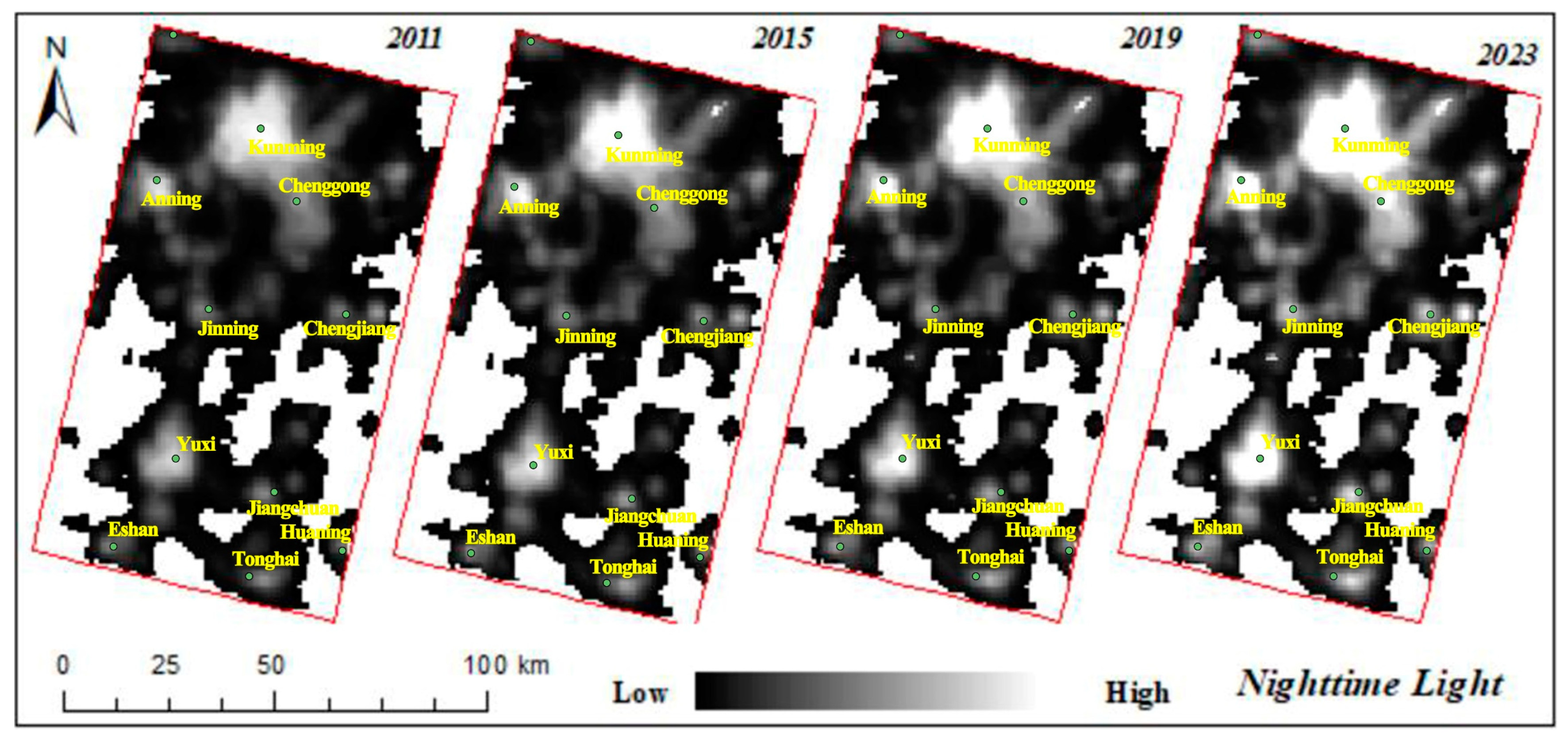
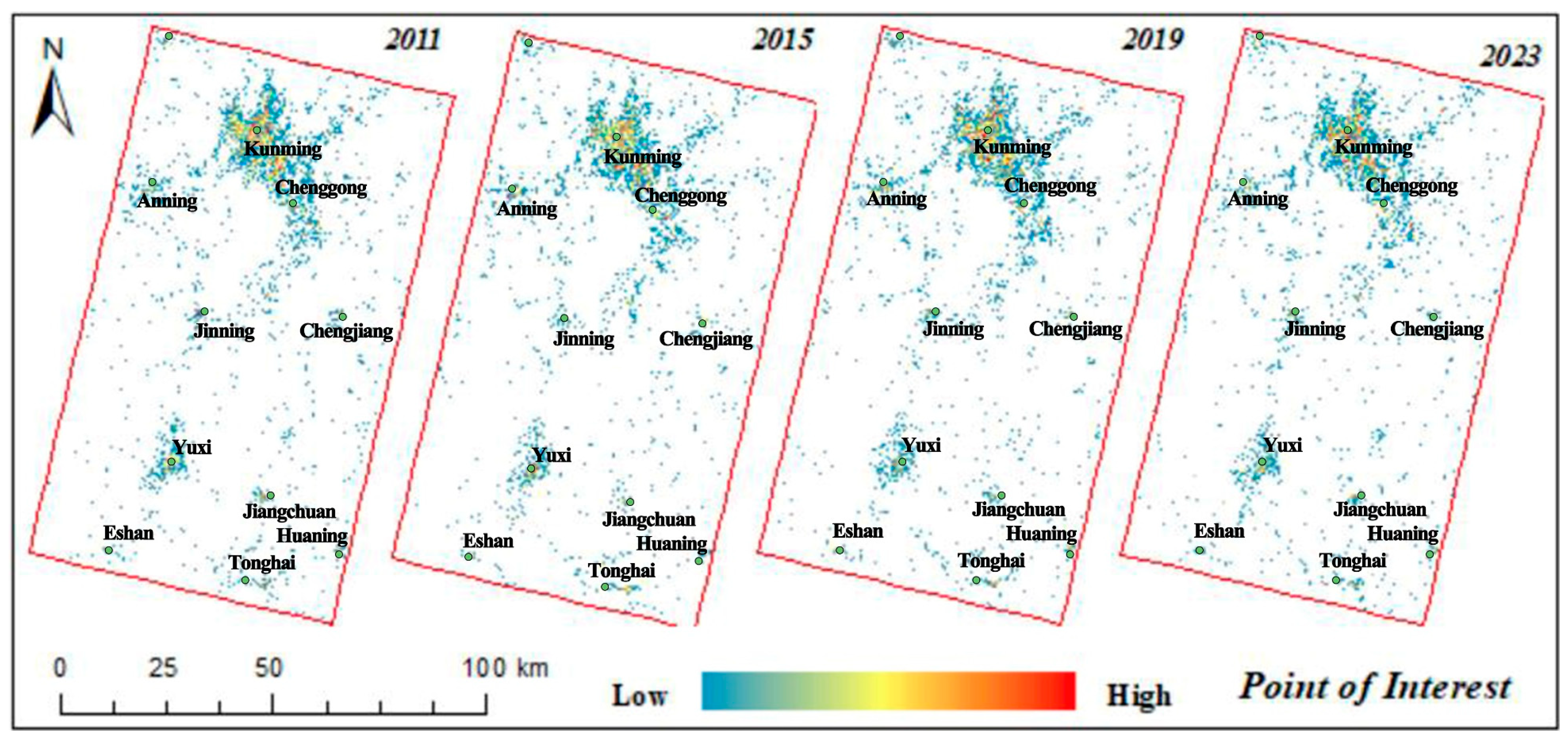

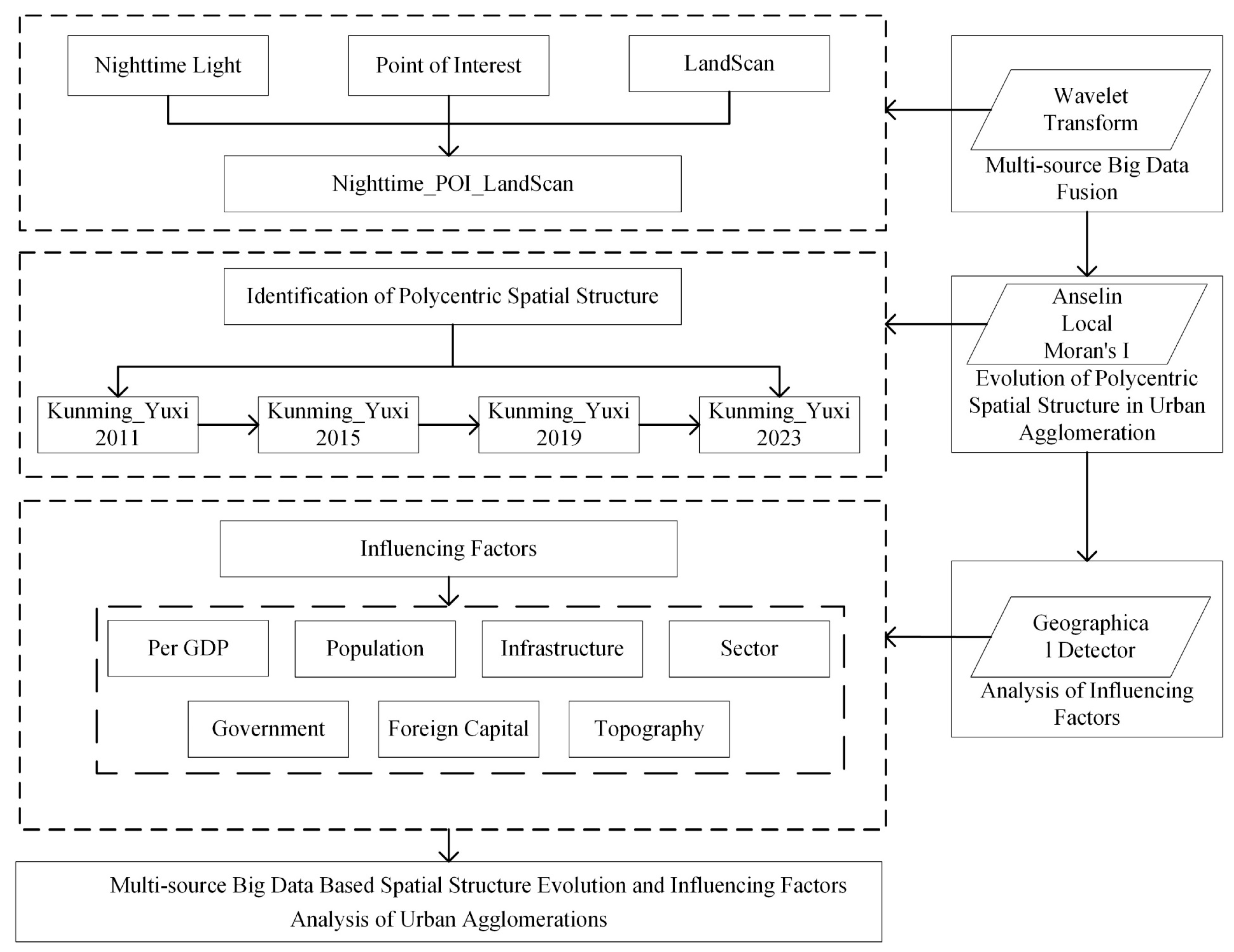
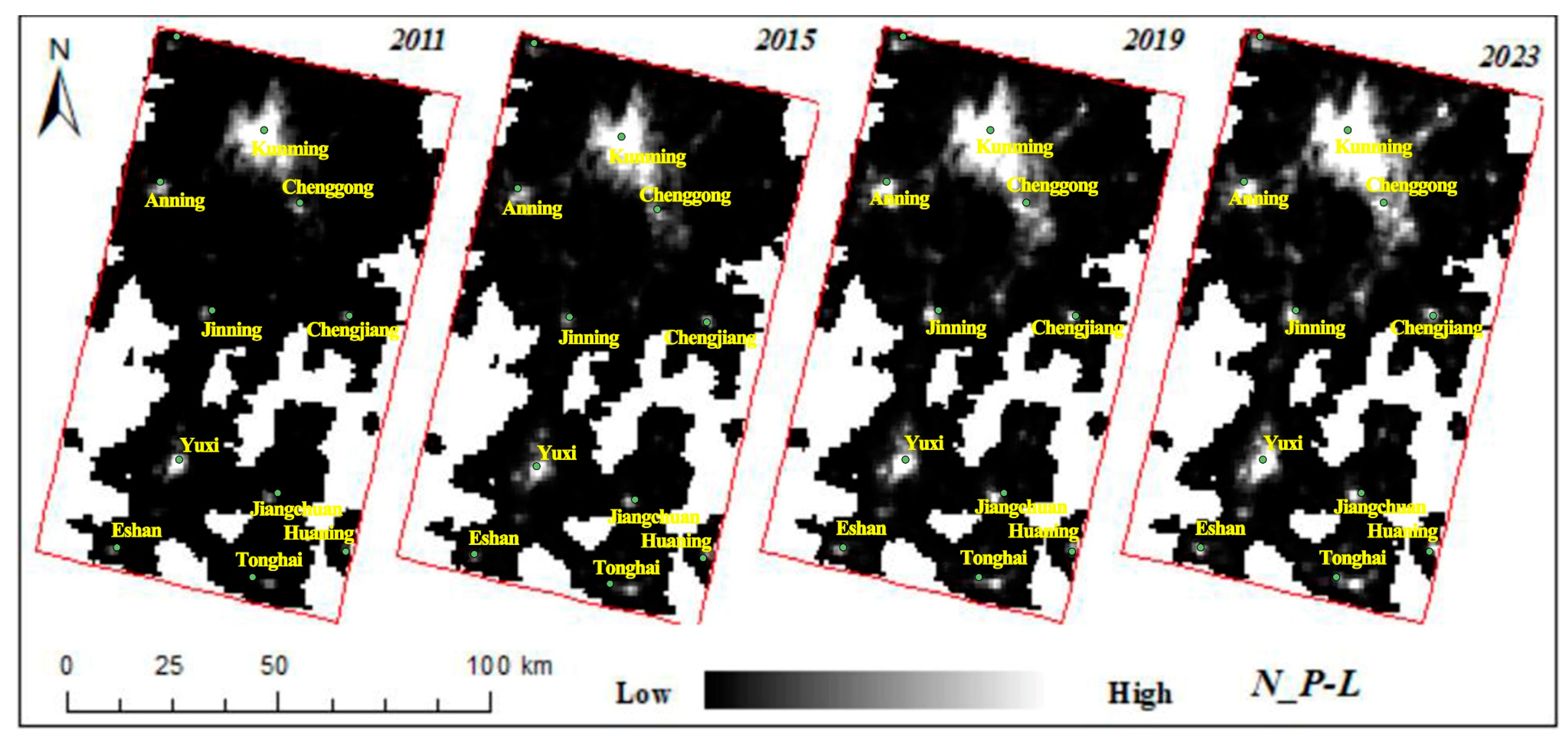
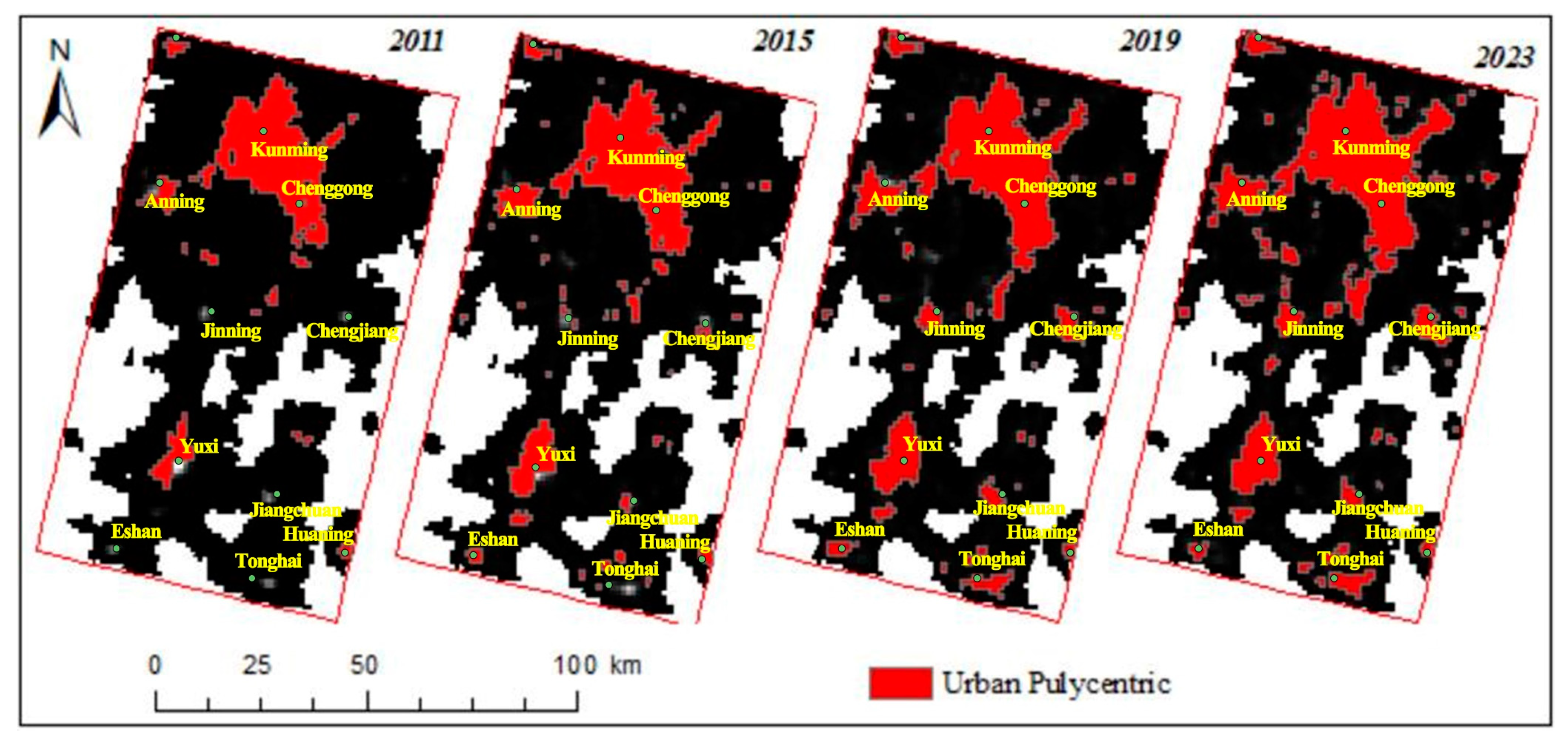

| Criteria | Formula | Urban Center | Nonurban Center | Definition |
|---|---|---|---|---|
| Area | is the number of pixels, CS is the size of the pixel. | |||
| Standard Deviation | >0 | ≈0 | is the value of the , is the average value of the pixels. | |
| Compactness Index | Approaching 1 | Approaching 0 | is the perimeter of the urban center. | |
| Extension Ratio | <3 | are, respectively, the length and width of the minimum bounding rectangle of the urban center. |
Disclaimer/Publisher’s Note: The statements, opinions and data contained in all publications are solely those of the individual author(s) and contributor(s) and not of MDPI and/or the editor(s). MDPI and/or the editor(s) disclaim responsibility for any injury to people or property resulting from any ideas, methods, instructions or products referred to in the content. |
© 2023 by the authors. Licensee MDPI, Basel, Switzerland. This article is an open access article distributed under the terms and conditions of the Creative Commons Attribution (CC BY) license (https://creativecommons.org/licenses/by/4.0/).
Share and Cite
Zhang, J.; Zhang, R.; Zhang, X.; Yuan, X. Polycentric Spatial Structure Evolution and Influencing Factors of the Kunming–Yuxi Urban Agglomeration: Based on Multisource Big Data Fusion. Land 2023, 12, 1340. https://doi.org/10.3390/land12071340
Zhang J, Zhang R, Zhang X, Yuan X. Polycentric Spatial Structure Evolution and Influencing Factors of the Kunming–Yuxi Urban Agglomeration: Based on Multisource Big Data Fusion. Land. 2023; 12(7):1340. https://doi.org/10.3390/land12071340
Chicago/Turabian StyleZhang, Jun, Runni Zhang, Xue Zhang, and Xiaodie Yuan. 2023. "Polycentric Spatial Structure Evolution and Influencing Factors of the Kunming–Yuxi Urban Agglomeration: Based on Multisource Big Data Fusion" Land 12, no. 7: 1340. https://doi.org/10.3390/land12071340
APA StyleZhang, J., Zhang, R., Zhang, X., & Yuan, X. (2023). Polycentric Spatial Structure Evolution and Influencing Factors of the Kunming–Yuxi Urban Agglomeration: Based on Multisource Big Data Fusion. Land, 12(7), 1340. https://doi.org/10.3390/land12071340





